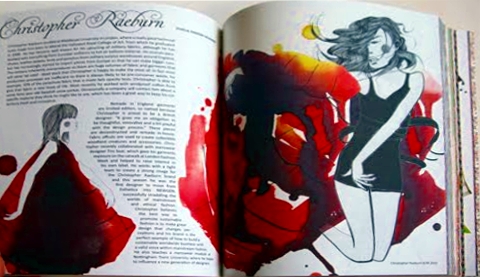 Amelia’s Compendium of Fashion Illustration
Amelia’s Compendium of Fashion Illustration
by A. Gregory (Editor)
ISBN: 9780956409515
Within a time span of just about 4 months, Amelia’s Compendium of Fashion Illustration is the second book, after Sass Brown’s ‘Eco Fashion’, that takes a stance in favour of a new generation of fashion designers. A generation of designers that has chosen to do things differently – sustainably to be precise – and not to be shy about it. And this in a time and age when an ethical fashion designer is often still smiled upon by his/her mainstream peers as their memories conjure up memories of Youtube Woodstock clips or primary school textile class experiences.
Given such a rather disputed context, ‘the compendium’ proofs that the topic of ethical fashion can be approached in a rather fun, original, and not the least colourful way: It combines short profiles of, or interviews with, 45 ethical fashion designers, with the work of 30 up and rising fashion illustrators, substituting the typical look book photographs with more stylised representations of a designer’s signature creations.

The range of designers portrayed in the book is broad: From long standing brands such as From Somewhere or Junky Styling to others that only rather recently stepped into the spot light of the public eye, among them for example Lu Flux and Little Glass Clementine.
Equally diverse is the commercial success of the portrayed brand as of to date. On the one end of the spectrum is for instance Edun, a brand that has become nearly a house-hold name already, which not the least is due to that half the shares belong to the Louis Vuitton group LVMH. And at the other end we find small designers that do mostly one off creations and work with each of their clients individually, such as is the case for Beautiful Soul.
What does this book add to what we know already about the portrayed fashion designers, and ethical fashion in general?
The combination of illustrations rather than photographs, and interviews with the (head) designer behind each brand gives us – for the first time ever – a hands on feeling for the personality that coins the cuts, shapes and colours we can appreciate on the runways and in presentations. And in this, the book is unique, fresh and fascinating. It’s the illustrations that are the real strength of this book.

There are a few minuses however. Some of the better known brands and designers, such as Ada Zanditon or Christopher Raeburn, are not present with an interview, but rather with a more or less well researched portrait only. This does unfortunately disrupt the overall consistency of the book quite unexpectedly, and also asks for a the reason behind this phenomenon. It also leaves the question if it had not been better to either replace those designers by one ready to give an interview, or leave them out altogether.
Also, from my very personal perspective, I would have thought it desirable to integrate designers beyond those that have been attending EstEthica in the last couple of editions. Ethical Fashion is by no means a British phenomenon, and by ignoring what is happening outside of London, London Fashion Week and the UK, Britain is given an importance as ‘the very best’ that it has no right to claim, I’m afraid.
Brands like L’Étranger from Spain, Ethos and Adamah Stein from France, Steinwidder or Milch from Austria, Isabell de Hillerin and Kaethe Maerz from Germany, Redesign the World from Italy, Elementum and Intoxica from Holland, Reet Aus from Estonia, or Visim and The Reracs from Japan are the proof that there is so much more going on than what is visible in London.
More importantly though: many of the designers from outside the UK have what the LFW/EstEthica circle lost in many cases. Namely the commitment to go down a different route, not only in how they produce, but also in how they design. What can be seen abroad is often truly innovative, ground breaking stuff, and at least in the same league with the ‘very best’ of Amelia’s Compendium.
This all said, I admittedly get hung in the book’s subtitle: ‘featuring the very best in ethical fashion design’. It’s quite strange how my brain choses to ignore that the illustrators are featured on the same level of importance as the designers.
If it were not for the subtitle, and as a drawingly-challenged person, I would have very happily enjoyed the colourful drawings while admiring the skill of the illustrators without bothering too much about what designers they represented. As long as all of them were ethical, of course. But as an ethical fashion professional (what a strange word! saying it all and yet nothing!) I always end up analysing the ‘facts and figures’ …
Should you buy this book?
If you are into fashion illustration: Yes.
If you are into what’s going on at the edges of high street fashion in London: Yes.
If you’re ‘just’ fascinated by fashion. Period. Then: Yes. This book will open your eyes to a whole new world of what fashion design can be about.
If you are ‘only’ in need of an interesting coffee table book with substance for some good, worthy conversation, then it’s a nobrainer: Yes.
Only if your main focus and background is ethical fashion, then it’s an ‘It depends’. It depends on how well you know what’s going on globally, and how familiar you are with what is going on at the core and orbit of EstEthica and LFW. But then again, one might as well expand horizons and learn about fashion illustration for a change and forget about the rest.
This book is available from your nearest book store, as well as online from Amazon.

